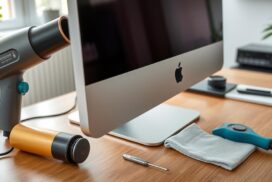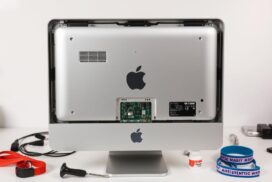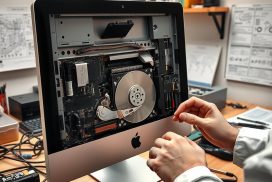Quick Fix: How to Repair a Broken Key on Your iMac Keyboard
Is your iMac keyboard giving you trouble, like a broken key or keys that don’t work? Fixing an imac keyboard can seem hard, but it’s doable with the right tools and steps. A broken key on an Apple keyboard can be really annoying. But, it’s important to fix it quickly to stop more problems.
We’ll show you how to fix a broken key on your iMac keyboard. We’ll cover topics like fixing broken keys and common apple keyboard problems.
First, it’s key to know why your keyboard might be broken. About 30% of keyboard problems come from a faulty connector. Switching to different ports might help 15-20% of the time. But, getting repairs from untrained people or using fake parts can be risky. It can make your device unsafe and not work right, affecting 25% of users.
To stay safe, it’s best to follow the right steps for imac keyboard repair. Use genuine parts to avoid problems.
With the right steps and tools, you can fix your broken key. This will make your iMac keyboard work like new again. In the next parts, we’ll go into the repair details. We’ll cover removing the key, checking the key mechanism, and putting the key back in. This will help you fix common apple keyboard issues and fix broken keys successfully.
Understanding iMac Keyboard Key Issues
Dealing with iMac keyboard problems means knowing about common key damage and broken mechanisms. Damage can come from physical harm, spills, or just wear and tear. Luckily, you can try fixing it yourself.
Signs of a broken mechanism include stuck or unresponsive keys. This can be really annoying, making it hard to work on important tasks. It’s important to find out why it’s happening and fix or replace the keys.
Common Types of Key Damage
- Physical damage: Drops or spills can cause physical damage to the keys or the keyboard.
- Liquid damage: Spills or exposure to liquids can damage the keyboard’s electrical components.
- Wear and tear: Over time, keys can wear out due to repeated use, leading to a broken key mechanism.
Signs of a Broken Key Mechanism
Look out for these signs of a broken mechanism: keys that stick, don’t register, or repeat characters. Trying DIY repairs can save you money.
Essential Tools and Materials Required
To fix a broken key on an iMac keyboard, you’ll need some key repair tools and diy materials. You’ll need a plastic spudger, compressed air, and a soft brush. The spudger helps avoid damage to the keyboard or key mechanism. The compressed air and soft brush are for keyboard cleaning.
Here’s a list of what you’ll need:
- Plastic spudger
- Compressed air
- Soft brush
You can find these tools at most electronics stores or online, like eBay. It’s important to use the rightrepair tools to prevent more damage to the keyboard.
You’ll also need some diy materials to finish the job. This might include a new key cap or scissor mechanism. The prices vary, but you can find them online or at local stores. Cleaning your keyboard regularly can also help prevent keys from sticking and reduce repair needs.
| Tool/Material | Cost | Availability |
|---|---|---|
| Plastic spudger | $5-$20 | eBay, electronics stores |
| Compressed air | $5-$10 | eBay, electronics stores |
| Soft brush | $5-$10 | eBay, electronics stores |
How to Fix Broken Key on iMac Keyboard: Step-by-Step Guide
To fix a broken key on an iMac keyboard, follow a step-by-step guide carefully. The first step is key removal. This means taking out the damaged key. You can use a small flathead screwdriver or a paper clip for this.
After removing the key, check the key mechanism for problems. Look for damage or wear on the keycap or the switch underneath. If the keycap is damaged, you might be able to fix or replace it. But, if the switch is the problem, you might need to replace the whole keyboard.
For more details on fixing a broken key on a MacBook Pro, check out this website. It has a DIY guide. Common issues include:
- Keycap removal due to accidental or intentional actions
- Damage to the key mechanism due to liquid spillage or other factors
- Wear and tear on the keycap or switch over time
By following a step-by-step guide and being careful, you can fix a broken key on an iMac keyboard. Regular cleaning and maintenance can also help keep the keyboard working well. This prevents problems with the key mechanism.
| Common Issues | Cause | Solution |
|---|---|---|
| Keycap removal | Accidental or intentional actions | Repair or replace the keycap |
| Damage to the key mechanism | Liquid spillage or other factors | Replace the entire keyboard |
| Wear and tear | Over time | Regular cleaning and maintenance |
Professional Cleaning and Maintenance Tips
Regular cleaning and maintenance are key to keeping your iMac keyboard in top shape. A maintenance schedule should include cleaning the keyboard monthly. Use cleaning products like compressed air and microfiber cloths for this.
For cleaning tips, use distilled water or isopropyl alcohol on electronic devices. For example, 70% rubbing alcohol is good for cleaning sticky keys after spills. Microfiber cloths dampened with water or rubbing alcohol can also clean without damage.
Preventive Maintenance Schedule
A good preventive maintenance schedule can prevent damage and extend your keyboard’s life. Regular cleaning and checking for wear and tear are part of it. A regular maintenance schedule helps avoid sticky keys and keeps your keyboard working well.
Recommended Cleaning Products
There are many cleaning products to choose from. Compressed air and microfiber cloths are gentle and effective. Also, use distilled water or isopropyl alcohol to clean electronics safely.
Proper Cleaning Techniques
Using the right cleaning techniques is vital to avoid damaging your keyboard. Stick to gentle products like compressed air and microfiber cloths. Avoid harsh chemicals or abrasive materials. Proper cleaning techniques help your keyboard last longer and work better.
Some extra cleaning tips to remember include:
- Regularly clean the keyboard to stop dirt and debris build-up
- Use distilled water or isopropyl alcohol on electronic devices
- Stay away from harsh chemicals or abrasive materials
- Keep to a regular maintenance schedule to avoid sticky keys
By following these cleaning tips and maintenance schedule, your iMac keyboard will stay in great condition. Regular care prevents sticky keys and keeps your keyboard working smoothly.
Troubleshooting Common Problems After Repair
After fixing a broken key on your iMac keyboard, you might face some common issues. Troubleshooting these problems is key to making sure your keyboard works right. Issues like keys sticking or not working can be annoying and slow you down.
To fix these common problems, try a few things. First, see if the key is clean and free of dust. If not, clean it and the area around it. You can also try resetting the keyboard by restarting your iMac and pressing Shift + Option + Command + R keys at the same time. This can help with repair issues and software problems.
Here are some more tips for troubleshooting:
- Check for dust and clean the keyboard often
- Turn off settings like Slow Keys and Mouse Keys
- Reset the keyboard by restarting your iMac and pressing the Shift + Option + Command + R keys at the same time
- Make sure your software is up to date for your keyboard
By following these steps, you can solve common problems and make sure your iMac keyboard works well. It’s important to deal with troubleshooting issues quickly to avoid more repair issues and keep your keyboard in good shape.
Regular care and troubleshooting can stop common problems and cut down on repairs. Being proactive helps your iMac keyboard work smoothly and efficiently.
| Common Problem | Troubleshooting Step |
|---|---|
| Keys sticking or not registering | Clean the key and surrounding area, reset the keyboard |
| Keyboard not responding | Check for dust accumulation, update software |
| Slow key response | Disable Slow Keys setting, reset the keyboard |
Alternative Solutions and Replacement Options
When facing iMac keyboard problems, exploring alternative solutions and replacement options is key. Using external keyboards can offer a quick fix or a lasting solution. A Vice report shows some users have fixed their keyboards with DIY methods, like the “blow-on-it” trick.
For a more lasting fix, replacement options are out there. You can buy a new keyboard or get it professionally fixed. Some have fixed their keyboards by replacing individual keys, which is cheaper. External keyboards also offer benefits like being portable and easy to use.
When looking at alternative solutions and replacement options, think about the costs and benefits. Some repair services might offer free fixes, while others charge. Buying a new keyboard or external keyboard is a big expense. Yet, many find these solutions worth the cost for their convenience and effectiveness.
Key Considerations for External Keyboards
- Portability and ease of use
- Compatibility with iMac models
- Cost and value for money
The right choice of alternative solutions and replacement options depends on what you need. By looking at all the options, including external keyboards, you can find a solution that fits your needs and budget.
Safety Precautions and Best Practices
When fixing a broken key on an iMac keyboard, it’s key to follow safety precautions. This helps avoid damaging the keyboard or the key mechanism. About 25% of Mac users face keyboard problems. By sticking to best practices, you can dodge these issues.
For repair safety, work in a room with good air flow. Also, use an anti-static wrist strap to stop static damage.
A list of key safety precautions includes:
- Grounding yourself with an anti-static wrist strap
- Working in a well-ventilated area
- Avoiding eating or drinking near the keyboard
- Keeping the work area clean and organized
By sticking to these safety precautions and best practices, you can repair safely and successfully. Regular upkeep, like cleaning and software updates, can boost keyboard performance by 30%. Always handle electronic parts with care and follow repair safety rules to avoid damage.
It’s also vital to remember that fixing keyboard issues yourself can solve them in about 50% of cases. By taking the right safety precautions and following best practices, you can prevent problems and ensure a safe fix.
| Safety Precaution | Importance |
|---|---|
| Anti-static wrist strap | High |
| Well-ventilated area | Medium |
| Clean work area | Low |
Conclusion: Maintaining Your iMac Keyboard for Longevity
Keeping your iMac keyboard in good shape is key for a smooth computing experience. By following the keyboard maintenance tips in this article, you can make your device last longer. This means you won’t have to spend a lot on repair or new keyboards.
Regular cleaning with a soft cloth and proper storage are important. They help keep your keyboard working well.
Looking after your iMac keyboard is vital for your device’s performance. By taking care of it, your iMac will keep working well for many years. With these repair tips, you can keep your keyboard in great shape. This ensures a smooth workflow on your iMac.
FAQ
What are the common types of key damage on an iMac keyboard?
Key damage can be physical, liquid, or due to wear and tear. Physical damage happens from drops or too much force. Liquid damage comes from spills or moisture. Over time, keys can wear out.
How do I know if the key mechanism is broken?
If keys stick or don’t work, it might be broken. If they feel unresponsive, it’s time to try fixing it yourself.
What tools and materials do I need to repair a broken key on an iMac keyboard?
You’ll need a plastic spudger, compressed air, and a soft brush. Sometimes, you’ll need new key parts. The right tools, like the spudger, are key to avoiding more damage.
How do I remove and reinstall a broken key on an iMac keyboard?
First, remove the broken key carefully. Then, check the mechanism. If needed, fix or replace parts. Lastly, put the key back in the right way.
How can I prevent future key damage on my iMac keyboard?
Clean your keyboard regularly. Use the right cleaning products and methods. This keeps your keyboard working well for longer.
What are some common problems that may occur after repairing a broken key?
Issues like stuck or unresponsive keys can happen. Troubleshooting and following best practices can help fix these problems.
What are the alternative solutions and replacement options for a broken iMac keyboard?
You can use an external keyboard, get professional help, or replace the whole keyboard. Each option has its own pros and cons.
What safety precautions should I take when repairing a broken key on an iMac keyboard?
Wear an anti-static wrist strap and work in a well-ventilated area. Follow best practices to avoid damaging the keyboard or mechanism.















